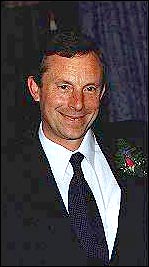– Dorothy – 1/5/97
“Rob seeks for a new way to promote peace – an alternative to the nuclear deterrent”
This is the forth of five articles about Commander Rob Green’s transition from trained nuclear killer and to a leading international peace activist. Be sure to read the
first article in the series before this one.
Just Defence to World Court Project The British anti-nuclear movement gave Rob a lot of media coverage. He needed support, but knew that it was useless to ask the British to give up their sense of security, which successive British governments had assured them depended upon their so- called “independent nuclear deterrent”, unless there was something to put in its place. An alternative form of defence was needed – one which had no need of nuclear weapons and
would not make enemies.
 |
| Rob Green |
The idea of non-provocative defence strongly attracted Rob. He joined a pressure group called Just Defence – a title which made play on the two meanings of ‘Just’, only defence, and defence which is lawful. From there he was plunged into the World Court Project (WCP).
A New Zealand initiative, the WCP aimed to get the United Nations to ask the International Court of Justice, or World Court, to give its advisory opinion on the legal status of nuclear weapons. Chemical and biological weapons are banned by treaty. Nuclear weapons are not, yet nuclear weapons are worse.
This legal avenue had not been tried before, and Rob quickly saw that it could be a winner. A few months later he went to a meeting of the WCP as an observer from Just Defence and came out as British Chair of the WCP.
Working outside Britain – The Peace Movement Aotearoa/New Zealand In July 1991, Kate Dewes, a New Zealand peace activist, had travelled to Britain to promote the WCP. Rob attended the WCP’s international launch in May 1992 in Geneva where Kate Dewes was a speaker.
In New Zealand at that time there was an inquiry into the safety of nuclear-powered warships. Kate asked Rob, with his naval connections, if he could help the anti-nuclear case. He recalled a British television programme about the banning of UK nuclear submarines from foreign port visits in case they had an accident. He sent a transcript of this programme to her. In August and September 1992 the movement organised a New Zealand speaking tour for Rob.
With Kate the Southern Hemisphere’s representative on the WCP International Steering Committee and Rob the British representative, they continued to meet around the world. In 1993 Kate visited Europe to help the campaign; and they lobbied the UN in New York when the Non-Aligned Movement of 113 member States tabled a General Assembly resolution asking the World Court to clarify the law on nuclear weapons. The resolution was adopted in December 1994, and the Court gave its advisory opinion on 8 July 1996, in which it found no legal circumstance for the threat or use of nuclear weapons.
Email facilitates the work A year earlier, Kate had been asked to present a paper on the WCP story at a conference on the future of the UN held at La Trobe University, Melbourne. Because of work and family pressures, she got approval for Rob to co-author it and then present it.
Rob takes up the tale: “I had recently joined the Internet – encouraged by Kate, who had discovered the power and cheapness of Email through her local
PlaNet(NZ) node in Christchurch. Exploiting the 12-hour time difference between UK and NZ, we wrote the 10,000-word paper in five days. Because of the time difference we were able to edit each other’s work with one working while the other slept, with the final draft being submitted by email to La Trobe, where it was formatted and printed. It was a dramatic demonstration of the Internet’s potential.
Check out next week’s exciting conclusion to the series… People Making Changes Main Page




